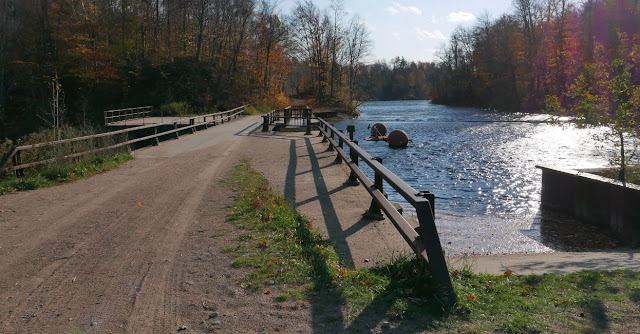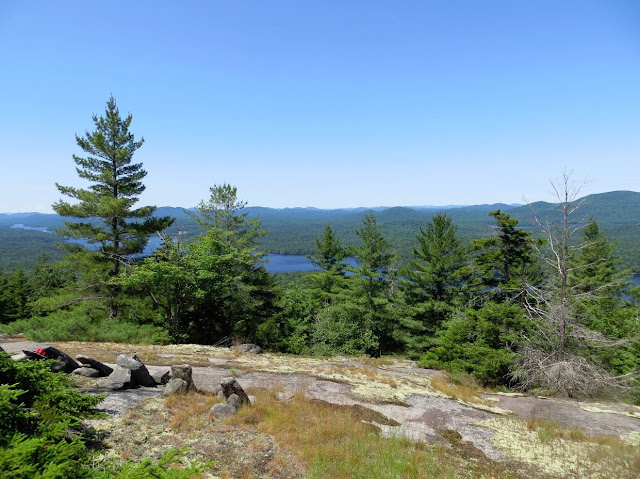This was my second attempt to reach Blind Mans Vly and this time I got there. My first try had been turned back by an
unexepected late-spring snow storm (on May 15th) and high water in East Canada Creek. This time I had a mild mid-October day and low water.
 |
| East Canada Creek just below Big Alderbed Vly. |
Blind Mans Vly is a small shallow pond just half a mile (as the crow flies) from Big Alderbed Vly. Big Alderbed can be reached via a snowmobile trail that leaves the Powley-Pisceco Road north of Stratford (2.7 miles). The trail to Big Alderbed tends to be wet but it is hiker friendly with the only possible challenge coming at the crossing of
East Canada Creek just below the vly (easy at except at times of high water). Blind Mans Vly is just 100 feet higher than the trail end at Big Alderbed. It is, however, tucked in between two small ridges and I discovered that it's a lot easier if go around the end of the interveening ridge. I went over the ridge and learned that it has a couple of bands of small cliffs that are surprisingly rugged. Much easier to go around.
 |
| The route as recorded by GPS and overlaid on Google Earth. |
Blind Mans Vly is an appealing destination but, even so, I don't often go back to places I've recently visited. There are so many new areas still left to explore. So the real reason for repeating this route lies in the trees themselves. The forests west of the Powley-Piseco Road, and the area around Blind Mans Vly in particular, are notable for the presence of old growth timber. Understanding and mapping the history of the Adirondack forest is my hobby so I wanted to take another look.
Happily, having returned and looked again, I've come away with new questions. Were these tracts logged? If cutting did take place when was it done and which species were taken? Three things stand out; the presence of large Red Spruce, the presence of very large Yellow Birch and what strikes me as an uncommon prevalence of Black Birch mixed in with the standard hardwood species. Spruce were the most sought after trees during the unregulared logging period of the late 19th and early 20th centuries. This route passes through scattered pockets of spruce some of which are 24 inches in diameter and greater. Spruce trees grow slowly so those are old trees. Also present are many very large Yellow Birch. A number of these trees are over 40 inches in diameter and a few elders push 48 inches. Like the spruce, Yellow Birch is a long-lived species so these are undoubedly old growth trees. As mentioned, there are also significant numbers of Black Birch mixed in. I don't recall having seen that species in such significant numbers elsewhere and I don't know what to make of that.
 |
| And old growth Yellow Birch with a diameter just under 48 inches. I didn't provide anything to show the scale so you'll have to take my word for it. |
The perplexing part is that the Red Spruce and Yellow Birch are the only species present that appear to predate the logging period. In a virgin forest I would expect to see large Maples and other hardwoods as well. And I would definately expect to find large Hemlock. And it's not that these species are absent. Maple and Hemlock are both fairly common along the route but the largest specimens are around 24 inches for the Maples and slight larger for a few of the Hemlock. For those speices that means the trees are unlikly to be much over 100 years old.
Maybe the old growth Maples were taken by loggers looking for just speicific hardwood species. Based on what I know about logging practices in those days that would have been unusual. The lack of old Hemlock is easier to understand. Hemlock bark was the essential raw material of the tanning industry that flourished in the southern Adirondack region in the late 1800s. So it's easy to imagine that the old growth Hemlock might have been taken while other species were ignored.
It would also be easy to overthink this. It could easily be that the combination of land ownership, forest composition and topography simply made this area less attractive to loggers than other nearby places. The East Canada Creek West Branch is large enough to float logs but between Big Alderbed Vly and the confluence of the west and east branches at Powley (near the starting point for this route) the creek passes through several long flat stretches where even the spring flood might not have provided enough water to move logs downstream. These meadows are filled with grass and they look like hay fields ready for harvest. That also strikes me as unusual. I'll guess I'll have to go back again.
 |
| Along East Canada Creek below Big Alderbed Vly. The creek meanders through several very flat grass-filled meadows. |
 |
| Very flat terrain. East Canada Creek is flowing through the middle of this sea of grasss. |
 |
| Big Alderbed Vly following an unusally dry summer. Quite different than the last time I was there with a heavy spring snow storm blowing through. |
 |
| A glacial erratic close to the north end of Blind Mans Vly. Yes there is a tree growing on top of the rock. |
 |
| The color was past peak but some bright spots remained. |
















































